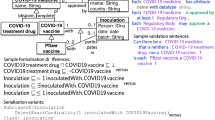Abstract
Linking, integrating, or converting conceptual data models represented in different modelling languages is a common aspect in the design and maintenance of complex information systems. While such languages seem similar, they are known to be distinct and no unifying framework exists that respects all of their language features in either model transformations or inter-model assertions to relate them. We aim to address this issue using an approach where the rules are enhanced with a logic-based metamodel. We present the main approach and some essential metamodel-driven rules for the static, structural, components of ER, EER, UML v2.4.1, ORM, and ORM2. The transformations for model elements and patterns are used with the metamodel to verify correctness of inter-model assertions across models in different languages.
Access this chapter
Tax calculation will be finalised at checkout
Purchases are for personal use only
Preview
Unable to display preview. Download preview PDF.
Similar content being viewed by others
References
See the list of collaborations (2014), http://www.tipharma.com/
Atzeni, P., Cappellari, P., Torlone, R., Bernstein, P.A., Gianforme, G.: Model-independent schema translation. VLDB Journal 17(6), 1347–1370 (2008)
Atzeni, P., Gianforme, G., Cappellari, P.: Data model descriptions and translation signatures in a multi-model framework. AMAI Mathematics and Artificial Intelligence 63, 1–29 (2012)
Banal-Estanol, A.: Information-sharing implications of horizontal mergers. International Journal of Industrial Organization 25(1), 31–49 (2007)
Bollen, P.W.L.: A formal ORM-to-UML mapping algorithm research memo RM 02/016, Faculty of Economics and Business Administration. University of Maastricht (2002), http://arno.unimaas.nl/show.cgi?fid=46
Bowers, S., Delcambre, L.M.L.: Using the uni-level description (ULD) to support data-model interoperability. Data & Knowledge Engineering 59(3), 511–533 (2006)
Boyd, M., McBrien, P.: Comparing and transforming between data models via an intermediate hypergraph data model. J. on Data Semantics IV, 69–109 (2005)
Calvanese, D., Lenzerini, M., Nardi, D.: Unifying class-based representation formalisms. Journal of Artificial Intelligence Research 11, 199–240 (1999)
Fill, H.G., Burzynski, P.: Integrating ontology models and conceptual models using a meta modeling approach. In: Proc. of 11th Int. Protégé Conference (2009); amsterdam 2009
Grundy, J., Venable, J.: Towards an integrated environment for method engineering. In: Proceedings of the IFIP TC8, WG8.1/8.2 Method Engineering, ME 1996, vol. 1, pp. 45–62 (1996)
Halevy, A.Y., Ashish, N., Bitton, D., Carey, M.J., Draper, D., Pollock, J., Rosenthal, A., Sikka, V.: Enterprise information integration: successes, challenges and controversies. In: Özcan, F. (ed.) SIGMOD Conference, pp. 778–787. ACM (2005)
Halpin, T.: Information Modeling and Relational Databases. Morgan Kaufmann Publishers, San Francisco (2001)
Hofstede, A.H.M.T., Proper, H.A.: How to formalize it? formalization principles for information systems development methods. Information and Software Technology 40(10), 519–540 (1998)
Hovy, E.: Data and knowledge integration for e-government. In: Digital Government, pp. 219–231. Springer (2008)
Keet, C.M.: Ontology-driven formal conceptual data modeling for biological data analysis. In: Elloumi, M., Zomaya, A.Y. (eds.) Biological Knowledge Discovery Handbook: Preprocessing, Mining and Postprocessing of Biological Data, ch. 6, pp. 129–154. Wiley (2013)
Keet, C.M., Fillottrani, P.R.: Structural entities of an ontology-driven unifying metamodel for UML, EER, and ORM2. In: Cuzzocrea, A., Maabout, S. (eds.) MEDI 2013. LNCS, vol. 8216, pp. 188–199. Springer, Heidelberg (2013)
Keet, C.M., Fillottrani, P.R.: Toward an ontology-driven unifying metamodel for UML class diagrams, EER, and ORM2. In: Ng, W., Storey, V.C., Trujillo, J.C. (eds.) ER 2013. LNCS, vol. 8217, pp. 313–326. Springer, Heidelberg (2013)
Louie, B., Mork, P., Martin-Sanchez, F., Halevy, A., Tarczy-Hornoch, P.: Data integration and genomic medicine. J. of Biomedical Informatics 40(1), 5–16 (2007)
Calo, K.M., Cenci, K.M., Fillottrani, P.R., Estevez, E.C.: Information sharing – benefits. Journal of Computer Science & Technology 12(2), 49–55 (2012)
Nelson, E.K., Piehler, B., Eckels, J., et al.: Labkey server: An open source platform for scientific data integration, analysis and collaboration. BMC Bioinformatics 12(1), 71 (2011)
United Nations Department of Economic and Social Affairs: United Nations E-Government Survey 2010 – Leveraging e-government at a time of financial and economic crisis. Tech. Rep. ST/ESA/PAD/SER.E/131, United Nations (2010), http://unpan3.un.org/egovkb/global_reports/10report.htm
Venable, J., Grundy, J.: Integrating and supporting Entity Relationship and Object Role Models. In: Papazoglou, M.P. (ed.) ER 1995 and OOER 1995. LNCS, vol. 1021, pp. 318–328. Springer, Heidelberg (1995)
Zhu, N., Grundy, J., Hosking, J.: Pounamu: A metatool for multi-view visual language environment construction. IEEE Conf. on Visual Languages and Human-Centric Computing (2004)
Author information
Authors and Affiliations
Editor information
Editors and Affiliations
Rights and permissions
Copyright information
© 2014 Springer International Publishing Switzerland
About this paper
Cite this paper
Fillottrani, P.R., Keet, C.M. (2014). Conceptual Model Interoperability: A Metamodel-driven Approach. In: Bikakis, A., Fodor, P., Roman, D. (eds) Rules on the Web. From Theory to Applications. RuleML 2014. Lecture Notes in Computer Science, vol 8620. Springer, Cham. https://doi.org/10.1007/978-3-319-09870-8_4
Download citation
DOI: https://doi.org/10.1007/978-3-319-09870-8_4
Publisher Name: Springer, Cham
Print ISBN: 978-3-319-09869-2
Online ISBN: 978-3-319-09870-8
eBook Packages: Computer ScienceComputer Science (R0)




